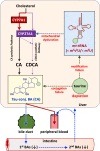Impaired bile acid metabolism with defectives of mitochondrial-tRNA taurine modification and bile acid taurine conjugation in the taurine depleted cats
- PMID: 32188916
- PMCID: PMC7080809
- DOI: 10.1038/s41598-020-61821-6
Impaired bile acid metabolism with defectives of mitochondrial-tRNA taurine modification and bile acid taurine conjugation in the taurine depleted cats
Abstract
Taurine that conjugates with bile acid (BA) and mitochondrial-tRNA (mt-tRNA) is a conditional essential amino acid in humans, similarly to cats. To better understand the influence of acquired depletion of taurine on BA metabolism, the profiling of BAs and its intermediates, BA metabolism-enzyme expression, and taurine modified mt-tRNAs were evaluated in the taurine deficient diet-supplemented cats. In the taurine depleted cats, taurine-conjugated bile acids in bile and taurine-modified mt-tRNA in liver were significantly decreased, whereas unconjugated BA in serum was markedly increased. Impaired bile acid metabolism in the liver was induced accompanied with the decreases of mitochondrial cholesterol 27-hydroxylase expression and mitochondrial activity. Consequently, total bile acid concentration in bile was significantly decreased by the low activity of mitochondrial bile acid synthesis. These results implied that the insufficient dietary taurine intake causes impaired bile acid metabolism, and in turn, a risk for the various diseases similar to the mitochondrial diseases would be enhanced.
Conflict of interest statement
The authors declare no competing interests.
Figures






References
-
- Awapara J. The taurine concentration of organs from fed and fasted rats. J. Biol. Chem. 1956;218:571–576. - PubMed
-
- Huxtable RJ. Does taurine have a function? Fed. Proc. 1980;39:2678–2679. - PubMed
-
- Sturman, J. & Hayes, K. In Advances in Nutritional Research Vol. Chapter 9 (ed. Harold H. Draper) Ch. 9, 231–299 (Springer, Boston, MA, 1980).
Publication types
MeSH terms
Substances
LinkOut - more resources
Full Text Sources
Miscellaneous

